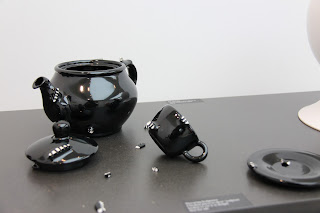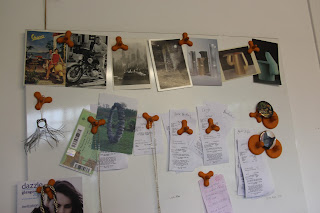It is the second time I write
about COLLECT in my blog. This year I have decided to follow my instincts and pick
objects that were attracting my attention without trying to understand why.
Back home, I did some research
about the artists I had selected. After having carefully read about the objects
I wanted to write about, I was amazed to discover that they are all linked by a
theme that I am currently researching with my own work: giving objects a second
chance. The 9 artists featured in this article use different strategies but
what they have in common is to use or reflect about “found” or “second-hand”
objects and give them a new existence.
In his introduction to “Thing
Theory”, Bill Brown proposes an interesting quote about them: “we begin to confront the thingness of
objects when they stop working for us”. Julian Stallabrass in his essay
“Trash” leads us into similar territory: “Commodities
are of course signs in a system of value, both monetary and social, which is
lost when they are abandoned. When objects are seen together as trash,
relationships of a more poetic and intrinsic interest emerge. The qualities of
the thing itself begin to appear in sharp relief like pictures in a developing
tray. […] their arbitrariness and alien nature are suddenly revealed.”
Some artists collect objects, pick
up trash in urban landscapes or the natural environment, pace up and down flea
markets. Their works use, distort, incorporate or are inspired by those “found objects”
and a new story appears where the object itself disappears to give way to a new
subject-object relation.
Some of them use different
strategies and create objects in the first place but then allow the works to
live a second life by altering them.
The first artist I have chosen is
Heidi Bjorgan in Galleri Kunst1.
Heidi is a ceramist and she
collects. “Overlooked objects, a lamp, an
old bread tin with an interesting shape or
knick-knacks of low value which have been discarded as trash or have ended up
in a car boot sale, that is what I collect. I give these forms a second chance
in a new guise, in a new context and sometimes I even add a new function. As a
maker my aim is through sampling and remaking to explore the aesthetic
potential of the shapes of these objects”, she says about her work. Her
works featured at COLLECT are porcelain vases cast from a plastic lampshade she
found in a skip. Other found objects have been added: a bird and little ceramic
bears are bound with the vase and both have been covered by glaze (pink or
blue) to transform the two parts into a whole. In Heidi Bjorgan;s work, worthless
discarded objects are transformed into beautiful and valuable craft.
For Graziano Gianocca, represented by Gallery SO, the creation is confrontation, an exchange between its internal world and the outside world. He is interested in the day-to-day objects, which he transforms to confer them a new identity. In his project “With Other’s Eyes” he uses anonymous photographs he has found on the web or in flea markets and carefully integrates them on the back of empty white or pink shiny square brooches. Only a second glance can reveal them. They function like 19th century lockets, which were pendants that opened to reveal a space used for storing a photograph or other small items such as hair. But the photos he uses are anonymous and with Graziano Gianocca’s work, one can wonder if those “found images” have the same emotional meaning than portraits of people we love?
Caroline Andrin’s work immediately caught my attention on the WCC.BF stand. At first, I didn’t actually understand what I was looking at. By getting closer and discussing with the artist, I started to understand that the “animal” trophies hanged on green backgrounds were made of clay cast in gloves. Caroline’s work questions our relationship with the objects we wear or use. She collects found objects such as gloves or woolly hats and uses them as moulds to create new shapes like those animal trophies. She believes that a shape can contain another shape and her wish is that her works keep the tracks of the objects used to create it. Each mould is used only once and destroyed when the work is turned out. From a certain distance they really look like animals. Get closer, and the viewer discovers that ears, noses, or chins are moulded from parts of leather gloves sewn together. Another very interesting manifesto about giving a second chance to objects…
At Lesley Craze Gallery, Maud
Traon’s rings were eye-catching. Combining materials such as Fimo clay,
electroformed copper, synthetic stones and found plastic toys, her rings are exuberant
and intriguing, oscillating between chaos and magic. In the exhibition booklet
“Also Known as Jewellery”, Michael Rowe perfectly describes Maud’s approach: “In her work, she confronts us with issues of
preciousness, value, durability, wearability, sensuality - explored with
particular reference to consumerism, social aspiration and taste, attitudes to
cultural differences, childhood and adult life. […] In some pieces we become
aware of toy cars, animals and other plastic models embedded in the clay and we
sense a poetic intent, those objects seem like fossilised toys, symbolic of
time passing perhaps, remains of a childhood locked in a mysterious
conglomerate ooze”.
In Maud’s work, found objects are
meant to be reassuring: for the viewer, by incorporating iconic and childlike
objects in apocalyptic landscapes, and for the artist by creating a starting
point to avoid facing the blank page syndrome.
I already mentioned Caroline
Slotte last year in “My Picks From COLLECT 2011”. I find her work thought
provoking and effective despite its apparent simplicity. This year she
exhibited two plates in Gallerie Sofie Lachaert. In her website she describes
her practice in a very interesting way: “The
most humble object can function as a key to the past, as a key to our inner.
The poetry of everyday objects, with all the memories and associations that
these objects contain: that is the starting point for my artistic practice. In
my work I examine the memory-bearing aspect of second-hand objects. […] What
role do the objects in our surroundings play in the creation of continuity in
our existence, and in the construction of a continuous life story? The
manipulation of existing material is central in my work. I rework found
objects, mainly second hand ceramic items, so that they take on new meanings. I’m
interested in how the interventions direct or obstruct the associations of the
viewer. The manipulated objects are characterised by a tension between the
recognisable and the mysterious, the familiar and the unfamiliar. I rework the ceramics by cutting directly into it, by
sculpting and sanding, and by combining elements from different objects. In
this way, the work process becomes a way of questioning the material and
highlighting stories contained in the objects”.
The two plates hung on the wall could
easily go unnoticed. The surface has been sanded leaving no colours and no
drawings but a small Asian-style house in a corner. The viewer has different
strategies possible: imagining what the plate looked like before being reworked
by Caroline or wondering if they would have notice this little house when the
plate was fully coloured and painted. As stated previously, a poetic interest
emerges from what was previously a simple commodity.
I have spotted Stuart Cairns’ work at the National Gallery Ireland’s stand. He is a silversmith and in his vessels series he mixes pristine silver shapes with twigs, nails and buttons. On his website he describes his practice as: “concerned with the exploration of materials through the objects of the everyday, specifically those around the familiar experience of dining at the table. These forms are re-imagined to investigate their narrative possibilities using a variety of materials, processes and found objects. Setting the play between materiality and form in the everyday experience I seek to touch upon the viewer’s sense of the familiar and divert it into an alternative narrative and association”. In Stuart’s work, found objects are accessories that, added to functional objects, distort their functions and force the viewer to reconsider the obvious.
Diana Hakim’s jewellery exhibited at Gallerie Louise Smit gives another interesting manifesto about found objects. On her website she states: “Familiar everyday commodities are often in use in my work. I transform them and give them a new meaning which offers the opportunity for a critical reflection. I choose these objects because they are loaded with meaning and have a cultural or associative presence. […] My jewellery collection comments on our society condition as a Fear Society. We are constantly afraid from the "other", from crime, terrorism, epidemics and more. The materials used are connected and related to and with safety, such as: nets, filters, ventilation covers, light reflectors, working gloves etc”. What I find interesting in Diana’s work is that using “fear related objects” to denounce our “Fear Society” could seem too obvious and simplistic but thanks to the awkward and fascinating aesthetic of her jewellery, it works. Her found objects become monsters that play in an unconscious level with our most intimate fears.
Anne Fischer, Juliane Scholss, Ja-Kyung are three artists exhibited at Galerie Rosemary Jaeger. They don’t work with found objects but give a second chance to pieces that they have created themselves. They describe their projects as: “Each of us made a classical candleholder comprised of 3 parts. Next, the 3 parts were separated and each one of us obtained a base, one handle and one socket each from separate makers. Then we built the candleholders from these parts. Each of us works very much in her own style. The decision of parting with one’s own work was not an easy one. It involves confidence and the ability to let go, but in the process there was also much spontaneity, joy and playful pleasure”. The result is quite original and it takes its inspiration from those games where somebody writes a word on a paper, folds it and passes it to another person, generally resulting in an amusing piece of gibberish. The 3 objects below seem chaotic but when associated with their story, they reveal their humanity. One cannot always choose who we are but we have to do with what we have. And it works… Those objects have a real second chance to exist.
Photos Isabelle Busnel
The last artist I would like to mention is Hugo Meert featured in the WCC.BF stand. On the gallery website one can read: “Hugo Meert observes everyday objects, diverts and distorts them. He keeps up a taste for objects bearing cultural or visual messages. His work pieces question on their own nature, this way a vase self-wrecks, a set of everyday objects becomes functional only once smashed. Over the past twenty years, this master of "shape and irony" has created an intriguing ceramics collection, characterised by a subtle "terrar" touch”. I particularly like this “tea set” which is a non-functional object until it has been smashed in pieces. Was the artist inspired by Marx’s quote: “a product becomes a real product only by being consumed. […] Only by decomposing the product does consumption give the product the finishing touch”? The second chance in this case is what makes the object useable. But once broken, what is its value? The scars it carries on the surface where the parts have been separated are the only proof it has once been a non-functional object and an artistic manifesto. So how to display such an object: broken or unbroken? At COLLECT Hugo Meert has chosen to show both.



































































